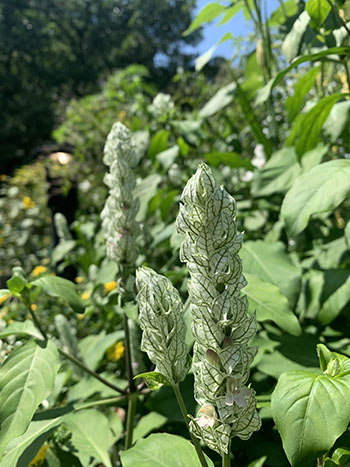
Plants of the Week: August 8
Guest Author: Summer Intern Mildred Arevalo

Ricinus communis ‘Carmencita’ commonly known as the castor oil plant is a mesmerizing annual herbaceous ornamental that belongs to the Euphorbiaceae family. With 5- to 12-lobed toothed glossy bronzed red foliage and bright red flowers, this is the only species in the monotypic genus; it naturalized in wastelands and stony slopes! This showy plant is an excellent addition to your summer garden and can be placed along borders and grows 6- to 10-feet tall. This plant can also be easily propagated by soaking the seeds for 24 hours and sowing before late spring in a 3-inch pot. This plant can be found in the Cut Flower Garden. Photo credit: M. Arevalo

These incredibly fragrant magical lilies are known for sprouting in the spring to then die back by June and make a comeback by early August. Known as the surprise lily, its Latin name is Lycoris squamigera. It’s recognizable by its bulbous and showy display with umbel pale pink flowers and incredibly long stamens that spill from the center. This plant originated in Japan and China on wooded hills and rocky sites. This would be great to include in your own garden on a sunny border and does not get many pests or diseases. Grows 18- to 28- inches. These flowers can be found along Magill Walk. Photo credit: M. Arevalo

Justicia betonica, otherwise known as white shrimp plant, is an upright perennial with small individual showy flowers that start off white and fade to lavender or pink flowers. They also exhibit didynamous stamens enclosed by three green veined white bracts. White shrimp plant likes full sun to bright indirect sunlight and can grow up to 5 feet. This upright shrub is originally from South Africa. This is an attractive herb to place in your garden that produces great ornamental flowers and can also be used in the garden as a shrub or groundcover. It can be found in the Scott Entrance Garden. Photo credit: M. Arevalo





Robert Roggeveen
Posted at 07:19h, 22 AugustDidynamous stamens – this got me up to consult a botanical reference book…. Thank you.